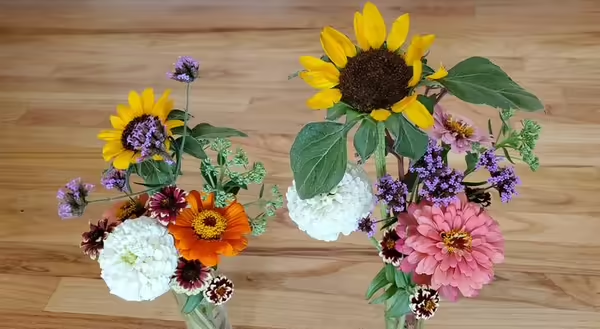
Life can be stressful.
Even the neighbor who plans perfectly feels hardships of life from time-to-time.
With a bundle of fresh flowers, the mood of friends or strangers is guaranteed to be uplifted, according to university research. In fact, this little dose of nature actually affects our emotional health and well-being. With bright, fresh blooms intimate connections are created with an immediate effect on our state of happiness and a long-term impact on our emotions, leaving us feeling more satisfied and fulfilled in life. Flowers not only visually brighten up a room, but they can brighten someone’s day (or week), too.
Our gardens are already filled with a variety of colorful blooms creating a peaceful landscape for us to appreciate and enjoy. With a cut flower garden, grow a garden of blooms for cutting without sacrificing the hard work of your landscape. Cut flower gardening is the practice of growing any plant for the sole purpose of harvesting the flower or foliage to use decoratively in an arrangement. A quality cut flower is determined based on the vase life. These examples of cut flowers can last up to a week in a vase of fresh water:
- Annuals: sunflower, zinnia, cosmos, gomphrena, celosia, calendula, snapdragons
- Bulbs: (spring flowering) daffodils, tulips, alliums; (summer flowering) dahlias, gladiolus, Asiatic lilies
- Perennials/Grasses: coneflowers, larkspur, Shasta daisy, yarrow, garden phlox, ornamental grasses, peonies,
- Shrubs: beautyberry, ninebark, smoke bush, bluebeard, hydrangea, rose, viburnum
Most of these plants need direct sun to guarantee the maximum quality and quantity of blooms. Cut flowers can be grown in raised beds, in-ground beds, pots, or containers, and can even be incorporated into your existing landscape. Get creative with your garden space and create a visually stunning space as the flowers grow and bloom.
Annual plants which complete their lifecycle in one year can be grown from seeds or from transplants bought locally. Seeds are a great option for versatility in plant selection and they cost less than transplants. However, some seeds are tricky to germinate, and purchasing transplants at the local garden center will save the work of nurturing seedlings into hardy plants.
Harvesting and arranging flowers can be both fun and fulfilling. Once you begin mixing different textures, colors, and varying bloom sizes, you may experience as much joy in the creation as you receive in the gift of giving.
Consider sharing the joy of freshly grown flowers with your neighbors, co-workers, or family this year through the Giving Garden program. With a pledge to donate at least 50% of the flower arrangements to someone in need of a “pick me up,” Illinois Extension will provide you with free seeds of six different plants and a monthly educational email newsletter to help you grow beautiful blooms to harvest, arrange, and gift. For more information about the program visit go.illinois.edu/GivingGarden.
ABOUT THE AUTHOR: Brittnay Haag is a Horticulture Educator with University of Illinois Extension, serving Livingston, McLean, and Woodford Counties. Her work focuses on youth horticulture education, specifically through school gardens and Jr. Master Gardener programs. Brittnay provides leadership for three county Master Gardener programs and is responsible for developing community programs and providing expertise in horticulture and environmental sciences.